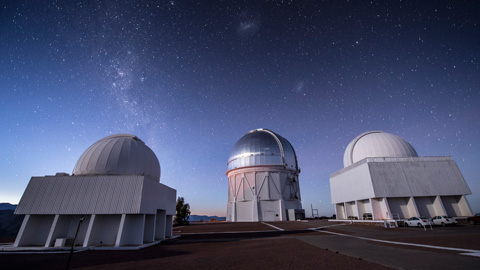The Dark Energy Survey completes its data collection mission

10/01/2019
The project began mapping a 5000-square-degree area of the sky on 31 August 2013 in a quest to understand the nature of dark energy, the mysterious force which is accelerating the expansion of the universe. DES scientists took data on 758 nights over six years using the Dark Energy Camera (DECam), a 520-megapixel camera funded by the US Department of Energy (DoE) and the Ministry for Science, Innovation and Universities of Spain, among other international organisations.
Making up the DES-Spain team are scientists from the Research Centre for Energy, Environment and Technology (CIEMAT), the Institute for Space Studies (ICE-CSIC)/Institute of Space Studies of Catalonia (IEEC), the Institute for High Energy Physics (IFAE) and the Institute for Theoretical Physics (UAM-CSIC). The camera is mounted on the Blanco 4-metre telescope at the National Science Foundation's Cerro Tololo Inter-American Observatory in Chile. DES-Spain's collaboration stood out especially in the construction of the DECam, given that the team was in charge of the design, verification, construction and installation of the greater part of the reading electronics.
Throughout these six years, researchers compiled data on over 300 million distant galaxies. More than 400 scientists from 26 institutions from all over the world have contributed to completing this project, which is hosted by the US Department of Energy's Fermilab (Fermi National Accelerator Laboratory). The collaboration has already produced over 200 academic papers, and many more are being prepared.
Enrique Gaztañaga, DES researcher at the ICE-CSIC/IEEC, highlights the fact that “DES-Spain was the first international collaboration to be conducted after founding DES more than 15 years ago. In this time, we have had the opportunity to gain experience in very different aspects related to a first line international project. It was our first joint project and the spark we needed for the DES-Spain team to begin working on new challenges and leading other equally ambitious projects such as EUCLID, PAUS and DESI”.
The DES collaboration continues releasing scientific results from their storehouse of data. The scientists discussed their most recent findings in a special session celebrated at the American Astronomical Society winter meeting in Seattle on 8 January.
“With the analysis of only a fifth of the data collected, the DES has already achieved to produce some of the most precise cosmological measures to date. With the analysis of the remaining data in the coming years, the DES will submit the current cosmological model - maintaining that dark energy exists due to the cosmological constant proposed and later rejected by Einstein - to the toughest test ever,” says Ramon Miquel, DES's main researcher at the IFAE.
The scientists collaborating in DES-Spain have had an important role in the analysis of data. In the cosmological results obtained until now, IFAE researchers have been leaders in determining the distance to the galaxies, essential in order to interpret the observations conducted, as well as in studying the correlations between the position of nearer galaxies to the shape of more distant ones. The ICE-CSIC/IEEC participated in the creation of dark energy maps, simulations and the study of galaxy clusters. The IFT-UAM/CSIC created synthetic catalogues to study systematic errors and covariance matrices. The CIEMAT is one of the institutions responsible for creating catalogues of the galaxies and the study of galaxy clusters, one of the evidences used to obtain cosmological results.
The Dark Energy Survey is a collaboration of more than 400 scientists from 26 institutions in seven countries. Funding for the DES Projects has been provided by the US Department of Energy, the US National Science Foundation, the Ministry of Science, Innovation and Universities of Spain, the Science and Technology Facilities Council of the United Kingdom, the Higher Education Funding Council for England, the National Center for Supercomputing Applications at the University of Illinois at Urbana–Champaign, the Kavli Institute of Cosmological Physics at the University of Chicago, the Center for Cosmology and Astro-Particle Physics at the Ohio State University, the Mitchell Institute for Fundamental Physics and Astronomy at Texas A&M University, Financiadora de Estudos e Projetos, Fundação Carlos Chagas Filho de Amparo à Pesquisa do Estado do Rio de Janeiro, Conselho Nacional de Desenvolvimento Científico e Tecnológico and the Ministério da Ciência, Tecnologia e Inovação, the Deutsche Forschungsgemeinschaft and the Collaborating Institutions in the Dark Energy Survey: www.darkenergysurvey.org/collaboration.